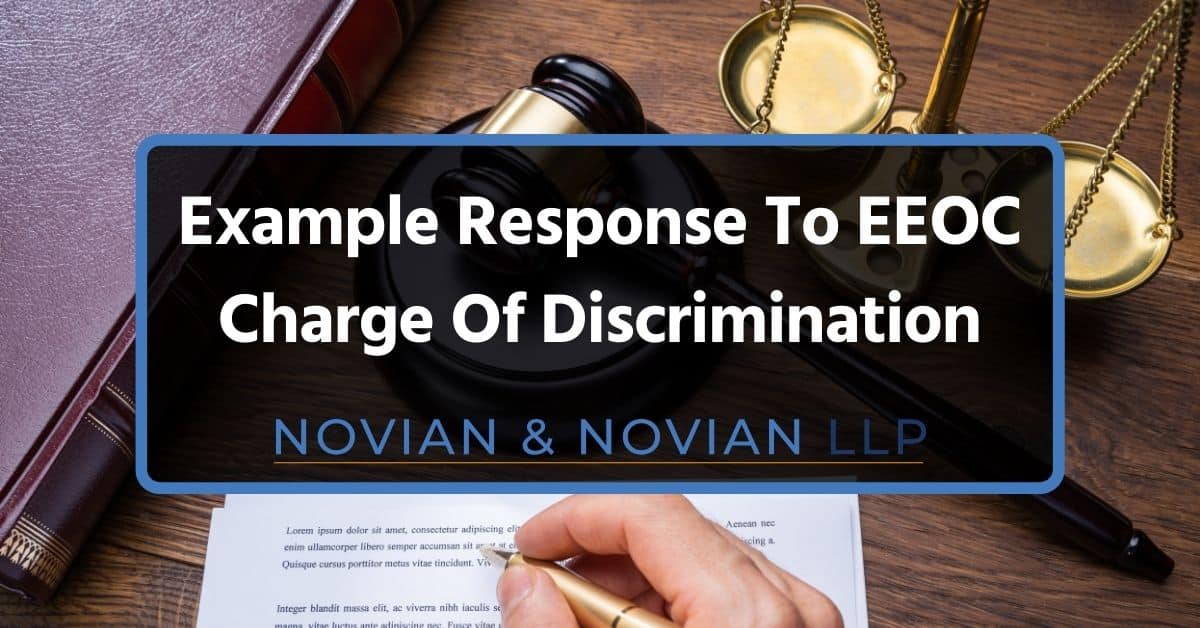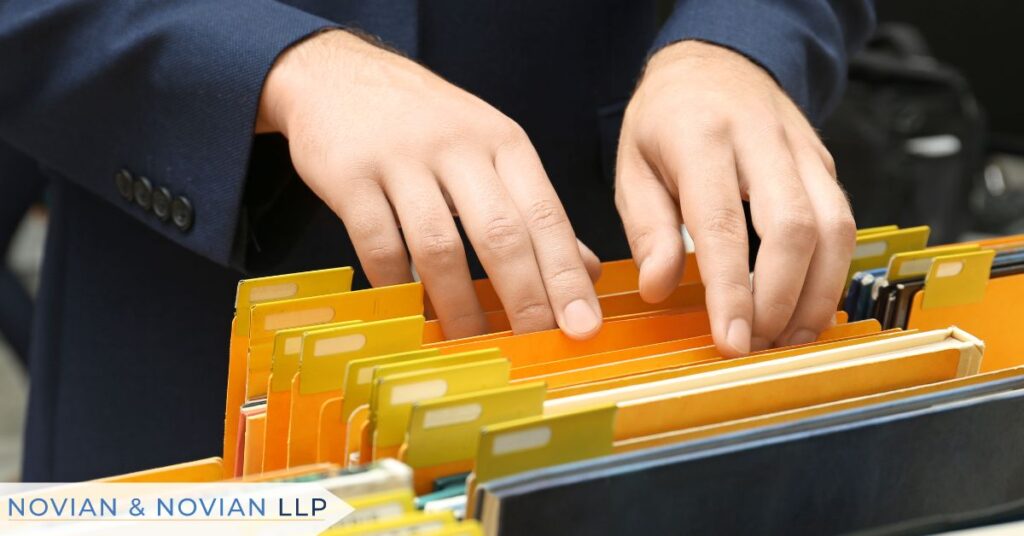
by | Feb 23, 2024 | Employment Law
Disclaimer: This blog provides general information about the Equal Employment Opportunity Commission (EEOC) and how the body’s authority applies to employees and employers. For more information about the commission’s purpose and jurisdiction, consult with legal experts like Novian & Novian to ensure that your company complies with the EEOC’s regulations and laws.
The EEOC is a federal agency that enforces federal laws that stand to protect employees or job applicants against discrimination based on their religion, race, age, national origin, genetic information, disability, or sex (such as sexual orientation, gender identity, and even pregnancy and pertaining conditions).
If you have received a notification of said charge, what is an example response to an EEOC charge of discrimination?
When an employer receives a charge of discrimination from the Equal Employment Opportunity Commission (EEOC), they typically have 30 days to respond. This time frame can vary depending on the specifics of the charge and the EEOC’s current backlog. The response to an EEOC charge is known as a “Position Statement,” where the employer is allowed to present its version of the facts and any supporting evidence.
Our experts at Novian & Novian have a deep understanding and experience with employment law and guiding employers through the nuance-filled practices of workplace regulations. With experience spanning over three and half decades, our attorneys are ready to help employers with workplace-related legal issues. To get started and learn more, don’t hesitate to contact us today.
This article aims to shed more light on EEOC charge response times and the legal compliance that employers have to provide to evade getting under the agency’s scrutiny.
How Long Does an Employer Have to Respond to EEOC Charges?
The regulations of the EEOC apply to most work environments and situations, such as promotions, hiring and firing, wages, benefits, training, and even sexual harassment and other persecution cases.
To start, the agency will investigate the Charging party’s claims that have been committed in the past 180 days. Sexual harassment and similar harassment cases are exceptions to this rule, as the agency needs to establish long-term patterns.
Also, when the Charging party’s claim has been filed against their workplace, the company will receive a notification of said charge of discrimination from the EEOC within roughly 10 days. Typically, afterward, the EEOC will give the Respondent (the employer) 30 days to send them a position statement with the required attachments and requested information responding to the charge.
During the investigation, the employer and the Charging party will be asked to provide more information about the charge. The EEOC investigator evaluates the information to determine if there’s reasonable cause to believe unlawful discrimination occurred. To be more precise, the investigator may require the company to:
- Submit a statement of position, allowing them to present the company’s position.
- Respond to a Request for Information (RFI), which may include providing personnel policies, personnel files, and other relevant information.
- Permit on-site visits.
- The agency may also send requests for additional information, such as employee contacts, or make them available for witness statements.
The investigation lasts about 10 months on average. During this time, the Charging Party may add to their existing charges and file new ones if any discrimination occurs during the meantime.
It’s worth mentioning that after the legal analysis of the charge, the agency may recommend mediation between the Charging Party and the employer. If they agree, they can either reach a voluntary settlement via the help of a legal mediator. Opting for mediation can significantly reduce the timeline of the procedures. It takes around three months or even less to resolve cases this way. However, if the parties cannot agree, the agency will send out an EEOC investigator who will be responding to the claim.
After completing an investigation, the EEOC will determine whether “reasonable cause to believe that discrimination occurred” exists. The agency will negotiate a voluntary settlement with the employer if the former is established.
If that fails, the case may be referred to the EEOC’s legal team. In rare instances, the agency itself may initiate a lawsuit to enforce the law, as it holds discretion over which cases to pursue. However, the EEOC will typically issue the Charging Party a “Notice of the Right to Sue.” This notice is often a prerequisite for filing a private lawsuit in federal court.
Preparing for (and Evading) Potential Charges
Arguably, the best way to stay in the clear when it comes to harassment and discriminatory actions in the workplace is by understanding all the relevant policies and regulations enforced by the EEOC. The following steps may also prove useful to avoid these procedures:
- Implementing Anti-Discrimination Policies
- Provide Regular Training
- Maintain Accurate Documentation
- Respond to Complaints
- Legal Counsel
- Review the Company’s EEO Policies and Procedures Regularly
- Conduct Internal Audits
- Maintain Open Communication
Extensions and Exceptions
In specific circumstances, additional time may be granted for the Respondent if it’s clear that they are focused on supplying the documentation on the case. Evidence of this would be at least a partial submission of the requested information.
Also, the standard timeline may lead to an expedited process or altered in the following cases:
- High Priority Cases
- Statutory Deadlines
- Public Interest Cases
- Settlement Negotiations
- Limited Resources
- Cooperation of Parties
- Consent Decrees or Agreements
- Emergency Situations
The Standard Process for EEOC Charges
These EEOC charges are formal complaints that suspect discriminatory acts based on characteristics already mentioned above. The Charging Party may be a job applicant and/or current or former employees who have been subjected to adverse action, harassment, or racial discrimination in their workplace.
The EEOC handles different discrimination claims related to harassment claims, retaliation, adverse action, pay, benefits, promotions, hiring/firing, workplace policies, between-employee interactions, and claims related to other processes, such as maternity leave, etc. Filing such charges can lead to significant strain between the employer and the Charging Party, often manifesting in increased tension, mistrust, and even workplace retaliation.
The purpose of the EEOC is to enforce federal employment laws that promote equal workplace and job opportunities for everyone and prohibit discrimination. The agency aims to conduct impartial investigations to determine whether any discrimination has occurred and aims to address any violations through appropriate means.
After the employer responds to an EEOC charge, the agency investigates further and may try to resolve the issue through mediation or legal action. If discrimination is found, the EEOC may sue the employer, but if not, the charging party may receive permission to file a lawsuit independently.
Consequences of Failing to Respond to an EEOC Charge
Ideally, the agency strives to mediate between the Charging Party and the Respondent to prevent lawsuits. However, if the company ignores both mediation and the EEOC’s requests, the agency will issue an order by the court (a subpoena). Not complying with said subpoena constitutes contempt of court, leading to jail time or fines, not to mention negatively affecting the company’s business and good standing.
The potential outcome of the agency’s investigation will highly depend on the case’s facts and the evidence the EEOC manages to gather. As mentioned above, EEOC investigators will often conduct interviews with witnesses and gather documents.
If the agents find no evidence of violation, the EEOC sends the “Dismissal and Notice of Rights” notice to the Respondent and the Charging Party, and the latter has 90 days to file their own lawsuit if they wish.
If the investigator does reveal harassment or discrimination, the EEOC will issue a “Letter of Determination” to the Charging Party and the Respondent to explain the results of the investigation. The agency works with both parties to resolve the case in these situations. If they come to a solution, the Charging Party will be asked to waive their right to go to court. The agency will decide whether the cases should go to court if there is no solution.
Due to their limited resources, the EEOC can’t file a lawsuit in every case when they find violations. If the agency doesn’t file a lawsuit, they will send out a notice of closing the case, and the Charging Party then has 90 days to file their own lawsuit.
Can an Employee Go Directly to Court Without Filing an EEOC Charge?
In short, the Charging Party can file workplace discrimination and harassment lawsuits directly without reaching out to the EEOC first. Still, most attorneys will recommend filing a charge first. The involvement of the EEOC and the investigator leaves more space for possible remedies and will also preserve the Charging Party’s rights to pursue legal action at a later time.
Best Practices for Employers
As an employer, you should provide a well-drafted position statement to the EEOC charge, including comprehensive information to explain the circumstances and reasons for adverse employment actions, demonstrating legitimate business reasons. Utilize supporting documentation such as attendance records and all following information such as emails to support and explain your version of events and discredit allegations. Also, ensure the accuracy of the response by verifying it with all involved parties, as misinformation could be detrimental in legal proceedings.
Then, highlight consistent past decisions to explain that the company enforced similar actions against individuals not belonging to the Charging Party’s class group or similarly situated employees. Furthermore, provide context about your company and your company’s business to help the agency understand your actions, especially if they may not be immediately apparent to an outsider.
It is important to keep confidential information regarding the charge non-public and limit information sharing to those who need to know, especially if the charging party is still employed. You also need to respond promptly and cooperatively to the charge, as delays can lead to adverse determinations.
Seek assistance from legal counsel to protect the company’s interests and ensure proper handling of the response. It will also come in handy to notify your insurer promptly, as discrimination charges may be covered under employment-practices liability policies. In addition, preserve all relevant documents and suspend routine practices that could result in the destruction of relevant records, particularly electronic information.
The last step is especially important as most courts impose harsh sanctions on a responding company that doesn’t adequately preserve relevant evidence. That said, organizations are encouraged to optimize internal company procedures to keep track of every document that may be relevant to the case. This may also mean that organizations may have to suspend some of their routine “cleaning practices” pertaining to regular record disposal, such as deleting internet usage records, voicemails, and emails.
Typically, experts recommend that a company should be cooperative and participate actively in the investigation, providing all requested information, documents, and position statements in a timely fashion. Companies should also be on top of their internal complaints, craft adequate performance improvement plans, and aim to impose clear anti-harassment policies.
Dispute Resolution With Novian & Novian
Adhering to EEOC timelines is essential for employers to demonstrate compliance, protect their rights, mitigate risks, and maintain credibility throughout the investigative process. It ensures effective participation in the resolution efforts and facilitates fair and transparent handling of discrimination allegations.
We at Novian & Novian highly encourage all employers to be proactive in addressing workplace harassment and discrimination claims. On that note, we also recommend seeking legal counsel if the situation calls for it. Don’t hesitate to contact our experts if you have any concerns or questions about such issues.
Contact Us
Have questions about this post? Novian & Novian is a full service law firm in Los Angeles with clients that span the country. Contact us today for a free consultation.
Contact Us
Have questions about this post? Novian & Novian is a full service law firm in Los Angeles with clients that span the country. Contact us today for a free consultation.




